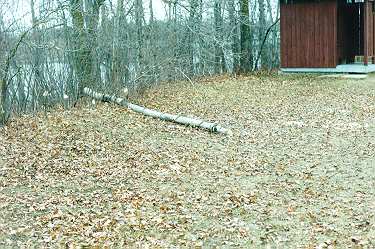Beavers are getting ready for the winter:
Cutting trees on the slope near the rest area
(between points 3 and 4)
Some information on the life of beavers will appear mainly on the pages to come (Beavers 3-6).
For more, see e.g. UoM Animal Diversity Web.

|
It was on the 2nd of November that I noticed for the first time that this year beavers started a large scale cutting of trees on the mainly aspen covered slope below the rest area at the eastern end of the bridge. This tree lying at the edge of the maintained lawn was clearly felled by a beaver. Its detached top lies a distance away on the left. |
|---|
| Next morning the top disappeared without a trace, and the trunk was nicely cleared of all the branches which were also hauled away. For whatever reason, the beaver(s) were not interested any more in the rest of the trunk, which was left until covered by snow at the beginning of winter. Note that that night the beaver(s) also managed to cut and completely haul away four more nearby trees (about 10 cm in diameter) as witnessed by four fresh spiky stumps that shine white near the foot of the lying trunk. On the first picture you can still see whole trees standing in their place a day before. |

|
|---|

|
Let us now return back to November 2. When I went down the slope, I saw more trees freshly felled by beavers. Although I found in that small grove a few old beaver stumps, at least during the last five years beavers never got to work in this place, frequented by some anglers, on such a grand scale as this fall. |
|---|
| At the foot of the slope on the small flat grassy ground near the fire pit, I found more felled trees. This picture also shows one of the beaver trails leading into the river, used by beavers to pull the branches and the logs cut from tree trunks into the river. Once in water, they can easily tug the wood towards their lodge which I later discovered north of the bridge. The spiky old stump in the middle of the upper end of the trail is one of proofs of beaver activity in this place in previous years (two other such stumps are hidden behind the grass on both sides of the trail). (Nov. 2) |

|
|---|

|
And this is a close-up of the two lying trees from the previous picture. In the foreground, one can see five piles of chips marking the places where beavers cut the left tree, of which not much had been left when the picture was taken, into smaller pieces which they can easily transport into their underwater stockpiles near the lodge. (Nov. 2) |
|---|
| And this and the next picture show the bottom of the river near the lower end of the trail from the last but one picture, with the whitish twigs stripped of bark by beavers. (Nov. 2) |

|
|---|

|
During the winter beavers live on tree bark. It seems that they eat on the spot some of the tastiest parts of the trees they are stockpiling as their winter food supply. (Nov. 2) |
|---|